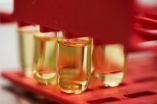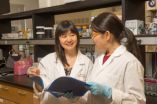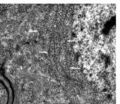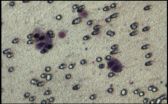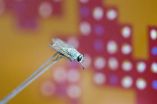(Press-News.org) PULLMAN, Wash. – Seeking ways to prevent some of the most serious foodborne illnesses caused by pathogenic bacteria, two Washington State University scientists have found promise in an ancient but common cooking spice: cinnamon.
Recent findings published in Food Control journal online suggest Cinnamomum cassia oil can work effectively as a natural antibacterial agent in the food industry. The study results add to a body of knowledge that will help improve food safety and reduce or eliminate cases of food poisoning and related deaths.
In the study, the essential oil killed several strains of Shiga toxin-producing Escherichia coli (E. coli), known to the U.S. Centers for Disease Control and Prevention as "non-O157 STEC." The study looked at the top six strains of non-O157 STEC, said co-author Lina Sheng, a graduate student in the School of Food Science.
The cinnamon cassia oil is effective in low concentrations, she said – about 10 drops diluted in a liter of water killed the bacteria within 24 hours.
Demand for natural food additives
Rising health concerns about chemical additives have strengthened demand for natural food additives, said co-author Meijun Zhu, an assistant professor in the School of Food Science.
"Our focus is on exploring plant-derived natural food bioactive compounds as antimicrobials to control foodborne pathogens, in order to ensure safety of fresh produce," she said.
Sheng said about 110,000 cases of illness are caused annually by non-O157 STEC.
The U.S. Department of Agriculture Food Safety and Inspection Service has a "zero tolerance" policy for the CDC top six non-O157 STECs in raw ground beef and trimmings, indicating any raw non-intact beef products containing these pathogens will be considered adulterated. This has led Zhu and Sheng to include the beef industry in the large-scale application of their findings on cinnamon.
"The oil can be incorporated into films and coatings for packaging both meat and fresh produce," Sheng said. "It can also be added into the washing step of meat, fruits or vegetables to eliminate microorganisms."
Cassia cinnamon is produced primarily in Indonesia and has a stronger smell than the other common cinnamon variety, Ceylon.
In addition to Cinnamomum cassia oil, Sheng plans to take a look at another natural source to kill bacteria. She and her coworkers will study the potential of dandelions to inhibit bacteria related to bovine mastitis, an infection in the mammary glands of dairy cows.
INFORMATION:
The article, "Inhibitory effect of Cinnamomum cassia oil on non-O157 Shiga toxin-producing Escherichia coli," will be published in the print version of Food Control in December 2014.
Preventing foodborne illness, naturally -- with cinnamon
Essential oil kills several strains of E. coli
2014-07-17
ELSE PRESS RELEASES FROM THIS DATE:
Anti-tank missile detector joins the fight against malaria
2014-07-17
State-of-the-art military hardware could soon fight malaria, one of the most deadly diseases on the planet.
Researchers at Monash University and the University of Melbourne have used an anti-tank Javelin missile detector, more commonly used in warfare to detect the enemy, in a new test to rapidly identify malaria parasites in blood.
Scientists say the novel idea, published in the journal Analysis, could set a new gold standard for malaria testing.
The technique is based on Fourier Transform Infrared (FITR) spectroscopy, which provides information on how molecules ...
Acupuncture and moxibustion reduces neuronal edema in Alzheimer's disease rats
2014-07-17
Aberrant Wnt signaling is possibly related to the pathological changes in Alzheimer's disease (AD). Axin and β-catenin protein is closely related to Wnt signaling. Zhou Hua and his team, Hubei University of Chinese Medicine, China confirmed that moxibustion or electroacupuncture, or both, at Baihui (GV20) and Shenshu (BL23) acupoints decreased axin protein expression, increased β-catenin protein expression, and alleviated neuronal cytoplasmic edema. These findings suggest that the mechanism underlying the neuroprotective effect of acupuncture in AD is associated ...
Who are responsible for protecting against neuron and synapse injury in immature rats?
2014-07-17
Fructose-1,6-diphosphate is a metabolic intermediate that promotes cell metabolism. Whether it can alleviate hippocampal neuronal injury caused by febrile convulsion remains unclear. Dr. Jianping Zhou, the Second Affiliated Hospital, Medical College of Xi'an Jiaotong University, China and his team established a repetitive febrile convulsion model in rats aged 21 days, equivalent to 3 years in humans, intraperitoneally administered fructose-1,6-diphosphate at 1,000 mg/kg into the rat model. Results showed that high-dose fructose-1,6-diphosphate reduced mitochondrial ...
Chemokine receptor 4 gene silencing blocks neuroblastoma metastasis in vitro
2014-07-17
Chemokine receptor 4 is a chemokine receptor that participates in tumor occurrence, growth and metastasis in vitro and its expression is upregulated during neuroblastoma metastasis. Dr. Xin Chen, the Affiliated Hospital of Qingdao University, China successfully constructed chemokine receptor 4 sequence-specific small interfering RNA (siRNA) plasmids, transfected into SH-SY5Y cells and found that down-regulation of chemokine receptor 4 can inhibit in vitro invasion of neuroblastoma. This paper was published in Neural Regeneration Research (Vol. 9, No. 10, 2014).
Article: ...
Intrathecal bumetanide has analgesic effects through inhibition of NKCC1
2014-07-17
Accumulating evidence has demonstrated that the sodium-potassium-chloride co-transporter 1 (NKCC1) and potassium-chloride co-transporter 2 (KCC2) have a role in the modulation of pain transmission at the spinal level through chloride regulation in the pain pathway and by effecting neuronal excitability and pain sensitization. Dr. Yanbing He Zhujiang Hospital, Southern Medical University, China and his team found that intrathecal bumetanide could increase NKCC1 expression and decrease KCC2 expression in spinal cord neurons of rats with incisional pain. The authors presumed ...
Attenuated inhibition of neuron membrane excitability contributes to childhood depression
2014-07-17
Accumulating evidence suggests that the nucleus accumbens, which is involved in mechanisms of reward and addiction, plays a role in the pathogenesis of depression and in the action of antidepressants. Dandan Liu and her team, Bio-X Institute, Shanghai Jiao Tong University, China for the first time using electrophysiological method studied the signaling transduction pathway mediated by dopamine D2-like receptor in the medium spiny neurons in the core of the nucleus accumbens in the juvenile Wistar Kyoto rat model of depression. They concluded that impaired inhibition of ...
NYU research on persons w/ HIV/AIDS not taking medication and not engaged in care
2014-07-17
Regular attendance at HIV primary care visits and high adherence to antiretroviral therapy (ART) are vital for people living with HIV/AIDS (PLHA), as these health behaviors lead to lowered rates of morbidity and mortality, increased quality of life, and reducing the risk of HIV transmission to others. However, a large proportion of PLHA in the United States are not sufficiently engaged in care and not taking ART when it is medically necessary.
A new study, "HIV-infected individuals who delay, decline, or discontinue antiretroviral therapy: Comparing clinic- and peer-recruited ...
Eradicating fatal sleeping sickness by killing off the tsetse fly
2014-07-17
A Brigham Young University ecologist is playing a role in the effort to curb a deadly disease affecting developing nations across equatorial Africa.
Steven L. Peck, a BYU professor of biology, has lent his expertise in understanding insect movement to help shape a UN-sanctioned eradication effort of the tsetse fly—a creature that passes the fatal African sleeping sickness to humans, domestic animals, and wildlife.
Using Peck's advanced computer models, crews from the UN's Food and Agriculture Organization will know where to concentrate their efforts to eliminate the ...
Investing in sexual and reproductive health of 10 to 14 year olds yields lifetime benefits
2014-07-17
WASHINGTON -- Age 10 to 14 years, a time when both girls and boys are constructing their own identities and are typically open to new ideas and influences, provides a unique narrow window of opportunity for parents, teachers, healthcare providers and others to facilitate transition into healthy teenage and adulthood years according to researchers from Georgetown University's Institute for Reproductive Health who note the lack worldwide of programs to help children of this age navigate passage from childhood to adulthood.
An estimated 1.2 billion adolescents live in the ...
Women's professional self-identity impacts on childcare balance, but not men's
2014-07-17
A new study finds that the more a woman self-identifies with her profession, the more paid hours she works and the less time she spends with the couple's children, but the more equal the childcare balance is between a couple.
However, the more a woman identifies herself with motherhood, the less time the father spends with the children.
And while the more a man self-identifies as a parent the more time he spends with children, this had no impact on the amount of time the woman spends on childcare – regardless of her self-identity.
The study, from Cambridge University's ...
LAST 30 PRESS RELEASES:
Missed signals: Virginia’s septic strategies overlook critical timing, study warns
Delayed toxicities after CAR T cell therapy for multiple myeloma are connected and potentially preventable
Scientists find cellular key to helping plants survive in saltwater
Medical cannabis program reduces opioid use
Immunotherapy works for sepsis thanks to smart patient selection
Cardiovascular events 1 year after RSV infection in adults
US medical prices and health insurance premiums, 1999-2024
Medical cannabis and opioid receipt among adults with chronic pain
Multichannel 3D-printed bioactive scaffold combined with siRNA delivery for spinal cord injury recovery
Triaptosis—an emerging paradigm in cancer therapeutics
A new paradigm in spectroscopic sensing: The revolutionary leap of SERS-optical waveguide integration and ai-enabled ultra-sensitive detection
Sweet tooth: How blood sugar migration in diabetes affects cavity development
Lowest suicide rate is in December but some in media still promote holiday-suicide myth
Record-breaking cosmic explosion challenges astronomers’ understanding of gamma-ray bursts
Excessive heat harms young children’s development, study suggests
Quanta Books to publish popular math and physics titles by Terence Tao and David Tong
Philanthropic partnerships fund next-generation instruments for mid-sized telescopes
AI offers ‘roadmap’ to plant genetics
Myosin XI-1: A key molecular target for salt-tolerant crops
Pusan National University study highlights the health hazards of ultrafine particles from small home appliances with electric heating coils and brushed DC motors
Global first: New Indigenous-led research initiative to revitalize legal orders
Transforming acoustic waves with a chip
When climate risk hits home, people listen: Study reveals key to engagement with disaster preparedness messaging
Major breakthrough against diabetes thanks to a microbial molecule that disarms inflammation
Silicon chips on the brain: Researchers announce a new generation of brain-computer interface
Getting rest is the best
Towards sustainable organic synthesis – Mechanochemistry replaces lithium with sodium in organic reactions
Wireless device ‘speaks’ to the brain with light
Greenhouse gases to intensify extreme flooding in the Central Himalayas
New study sheds light on Milky Way's mysterious chemical history
[Press-News.org] Preventing foodborne illness, naturally -- with cinnamonEssential oil kills several strains of E. coli
